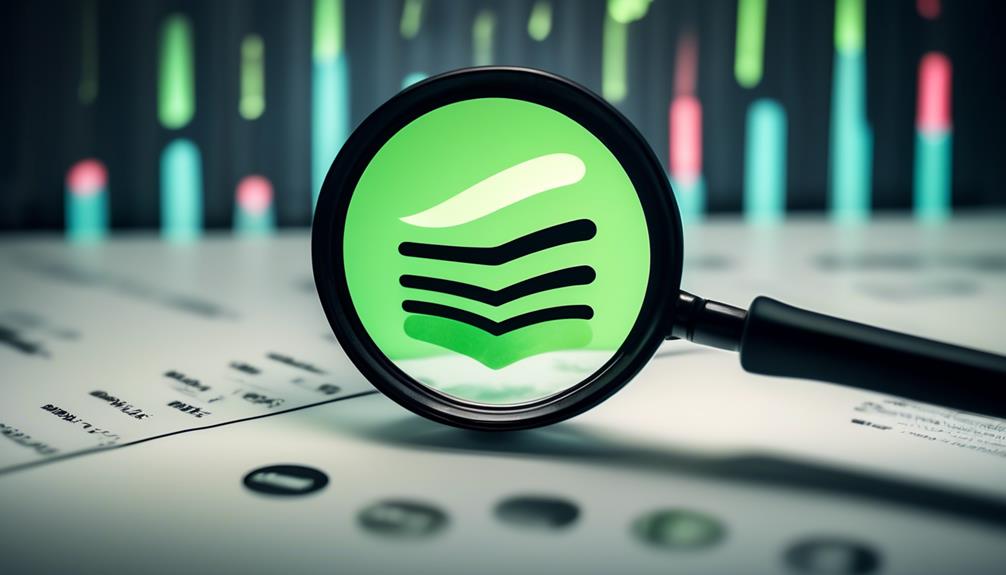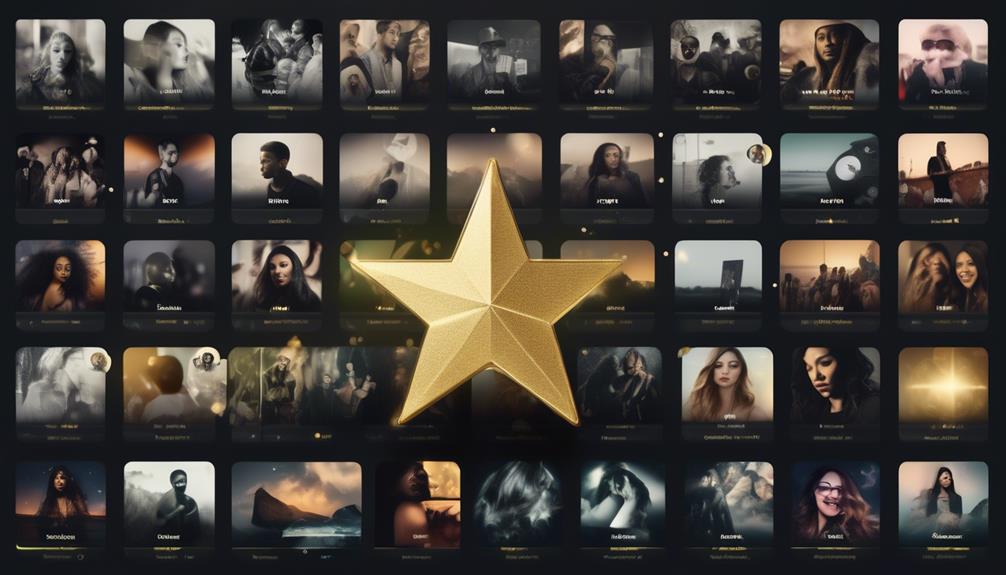
How many monthly listeners on Spotify is considered popular?
So, you’re wondering what constitutes popularity on Spotify, specifically in terms of monthly listeners. It’s a common curiosity, especially for budding artists and passionate podcasters aiming to make their mark on this globally recognized platform.
The number can seem elusive, with top artists boasting millions of monthly listeners, while others struggle to break into the thousands. So, where does the line of popularity lie? Is it a set number, or is there more nuance to the tale?
Stay with us as we unravel this intriguing question, offering insights that may redefine your perception of popularity on Spotify.
Key Takeaways
- Spotify’s ranking system takes into account various factors such as plays, engagement, social sharing metrics, and geographical distribution of listeners to determine an artist’s popularity.
- The number of monthly listeners on Spotify represents the unique number of people who have played an artist’s music within the last 30 days, focusing on individual ears reached rather than the number of times a song is played.
- Collaborating with other artists and strategically placing songs on high-traffic playlists can significantly boost an artist’s monthly listenership.
- Viral hits can have a massive impact on an artist’s listenership, potentially transforming their career overnight.
Understanding Spotify’s Ranking System

You might be wondering how Spotify determines its ranking system, and it’s quite an intricate process. Spotify’s algorithm secrets lie in its ability to analyze millions of data points, including the number of plays, listener engagement strategies, and social sharing metrics. The algorithm isn’t just about volume, it’s also about the intensity of interaction.
The music streaming giant uses a complex system of data analysis and predictive modeling to determine the popularity and ranking of tracks and artists. Listener engagement strategies play a huge role in influencing the algorithm. The more a track is played, shared, added to playlists or favored by users, the higher its rank becomes.
Spotify’s algorithm also takes into account the geographical distribution of listeners. If a song is popular in many different regions, it’s likely to rank higher. Moreover, the algorithm pays attention to the velocity of a song’s popularity. A sudden spike in listens can propel a track up the charts.
In essence, Spotify’s ranking system is a dynamic blend of data science and user behavior. It’s not just about counting listens, but understanding the way users engage with music. This innovative approach is what sets Spotify apart in the crowded music streaming landscape.
Decoding Monthly Listeners Metrics
Ever wondered what the ‘Monthly Listeners’ metric on Spotify means and how it’s calculated? Let’s delve into it.
This metric denotes the unique number of people who’ve played an artist’s music within the last 30 days. It’s not about how many times a song is played but rather, how many individual ears the music has reached.
Understanding this metric involves grasping two crucial elements: listener demographics and platform algorithms.
Spotify’s algorithm is a complex beast that uses user behavior and data to feed its recommendations, thereby influencing who hears what. Listener demographics, on the other hand, refer to the age, location, and gender of the listeners.
The way Spotify’s algorithm interacts with these demographics is key to the number of monthly listeners an artist can amass.
In essence, the more diverse your listener demographics, the better your chances of reaching a wider audience through Spotify’s algorithm. So, while the number itself is important, the underlying factors that contribute to it are even more so.
Being aware of these can help you strategize your music promotion to boost your Spotify popularity.
The Role of Playlists in Popularity

Consider how playlists impact popularity on Spotify.
The placement of a track on a high-traffic playlist can generate a surge of organic listeners, elevating an artist’s overall popularity.
Further, don’t overlook the potential of collaborative playlists, which can serve as a powerful tool for networking and exposure.
Playlist Placement Impact
The strategic placement of songs onto popular playlists can significantly boost an artist’s monthly listenership on Spotify, transforming them from relative obscurity to a chart-topping sensation. Playlist algorithms play a crucial role in this process. They curate songs based on listener engagement, such as the number of plays, likes, and shares.
The more engagement a song receives, the higher its chances of appearing on popular playlists. This, in turn, increases its visibility to a broader audience. Hence, it’s not just about producing great music, but also about understanding and leveraging Spotify’s playlist algorithms.
Generating Organic Listeners
Building on the idea of playlist algorithms boosting an artist’s visibility, let’s explore how these playlists can help generate organic listeners, a key factor in an artist’s sustained popularity on Spotify.
- Social Media Promotion: Use your platforms to share your playlist placements. This not only boosts your visibility but also draws new listeners who may become fans.
- Fan Engagement Strategies: Connect with your audience. Respond to their comments, share their posts, and make them feel valued.
- Quality Content: Ensure your music is top-notch. Good music attracts and retains listeners.
- Consistency: Regularly release music and stay active on social media. This keeps you in the minds of your listeners and the algorithms.
Collaborative Playlist Opportunities
In your journey to Spotify stardom, don’t overlook the potential of collaborative playlists, a powerful tool that can significantly amplify your reach and increase your popularity.
By participating in playlist curation, you’ll expose your music to new listeners, enhancing user engagement and fostering a community around your sound.
Collaborative playlists offer a unique opportunity to cross-pollinate your fan base with those of other artists, increasing the likelihood of discovery and virality. It’s a network effect that can turbocharge your streaming numbers.
So, go beyond just creating your playlists. Collaborate, innovate, and engage with other creators – your potential listener pool will grow exponentially.
When executed correctly, collaborative playlists are a game-changer, transforming the way your music is discovered and shared on Spotify.
Top Artists and Their Listener Count

Diving into the vast ocean of Spotify’s user statistics, you’ll find an intriguing fluctuation in the listener count of top artists. This ebb and flow are heavily influenced by artist branding strategies and the impact of live performances.
Now, let’s peel back the curtain on the numbers game and analyze a few top artists and their listener count.
- Ed Sheeran – This British crooner consistently stays at the top, with over 72 million monthly listeners. His global appeal is bolstered by a clever branding strategy and unforgettable live shows.
- Ariana Grande – With over 50 million monthly listeners, Ariana’s powerful vocals and impactful performances keep her listeners hooked.
- Bad Bunny – This Latin music sensation boasts about 35 million monthly listeners. His unique blend of reggaeton and trap music, combined with a strong brand, resonates with a global audience.
- Billie Eilish – This Gen Z icon has over 45 million monthly listeners. Her innovative music style and distinct brand image set her apart from her contemporaries.
Influence of Viral Hits on Listenership
Consider the massive impact a viral hit can have on an artist’s listenership; it’s not just a spike in popularity, but a potential game-changer in their career. You’ve seen this phenomenon in action, where artists explode onto the music scene seemingly overnight, with their listenership skyrocketing as a result of a single hit. The power of viral marketing strategies can’t be overstated in these scenarios.
Hit song analyses often reveal the strategic decisions behind these viral successes. It’s not just about producing a catchy tune; it’s about understanding the dynamics of the audience, the platform, and the zeitgeist. The right song, released at the right time, can work wonders.
Take Lil Nas X’s ‘Old Town Road,’ for example. This song became a viral sensation on TikTok before crossing over to Spotify, where it amassed millions of monthly listeners. It transformed Lil Nas X from an unknown artist into a household name.
Comparison With Other Streaming Platforms

You’ve seen how Spotify measures up in terms of monthly listeners, but how does it compare to other platforms?
It’s time to analyze how metrics differ across various streaming services, and what these differences mean for popularity benchmarks.
Let’s dissect the complexities of these platforms, and gain a deeper understanding of the competitive landscape in the music streaming industry.
Streaming Platforms’ Metrics
Comparing Spotify’s metrics with other streaming platforms, you’ll find notable differences that speak volumes about user behavior and preference. These differences are mainly in revenue generation streams and artist discovery algorithms.
- Revenue Generation Streams: Spotify’s freemium model sets it apart. It earns from ads and premium subscriptions, while others rely solely on subscriptions.
- Artist Discovery Algorithms: Spotify’s algorithms are known for their precision, giving it an edge in user personalization.
- User Interface: Spotify’s user-friendly design encourages more user engagement.
- Playlist Curation: Spotify’s user and algorithm-based playlists outshine others, fostering a unique musical journey.
These metrics not only impact Spotify’s popularity but also shape the future of music streaming. Understanding them enables you to navigate the industry’s transformative tide.
Popularity Benchmarks Comparison
When evaluating the popularity benchmarks among various streaming platforms, it’s clear that Spotify’s monthly listeners metric offers a unique insight into its platform’s usage and reach.
Compared to other platforms, Spotify’s popularity metric is more transparent, allowing artists to deploy effective artist branding strategies.
Meanwhile, platforms like Apple Music focus on album sales and song downloads, which may not fully capture listener engagement techniques.
On Spotify, a higher number of monthly listeners could indicate a more engaged audience or a successful branding strategy.
However, on platforms like Tidal or Amazon Music, the benchmarks might be different, focusing more on album exclusivities or playlist features.
Therefore, it’s crucial to understand each platform’s popularity benchmarks to maximize your audience engagement and artist branding.
Tips to Increase Monthly Listeners
Increasing your monthly listeners on Spotify isn’t a cryptic process; with a strategic approach and persistent effort, you can significantly boost your audience reach. Utilize Social Media Promotion and Listener Engagement Strategies as your primary tools in this endeavor.
Here are four action-oriented tips to skyrocket your Spotify listenership:
- Leverage Social Media: Use platforms like Instagram, Twitter, or Facebook to promote your music. Sharing a link to your Spotify profile or playlist can attract your social media followers to your Spotify account.
- Engage with Your Listeners: Respond to comments, create polls, or host Q&A sessions on social media. This not only builds a sense of community but also increases listener loyalty and encourages more streams.
- Release Music Consistently: Regularly releasing new music keeps your audience engaged and eager for more. This consistent influx of content boosts your visibility on Spotify.
- Collaborate with Other Artists: Collaboration exposes you to a new fan base and can lead to a significant increase in monthly listeners.

